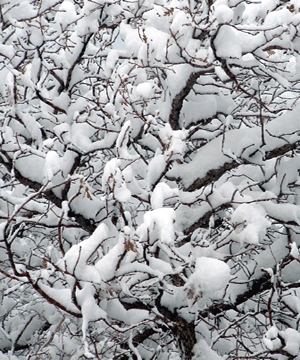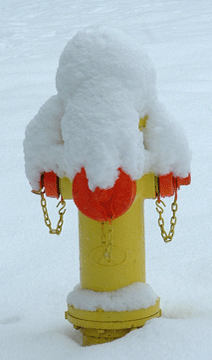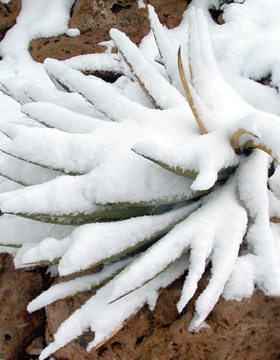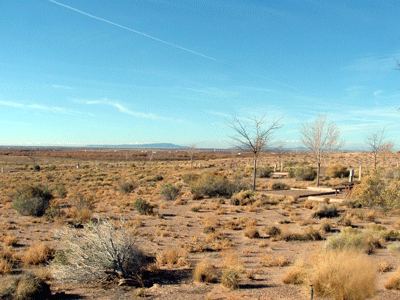 |
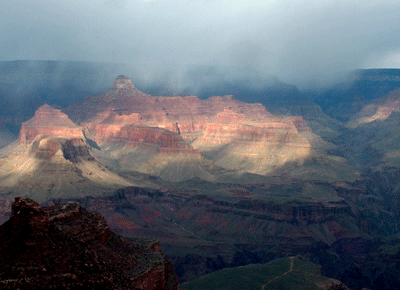 |
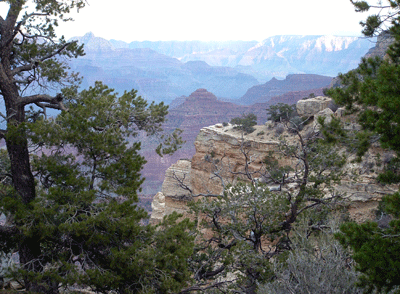 |
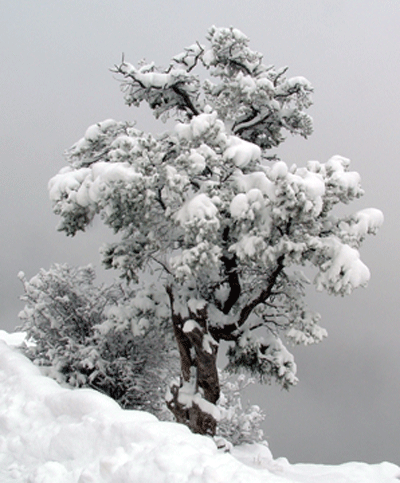 |
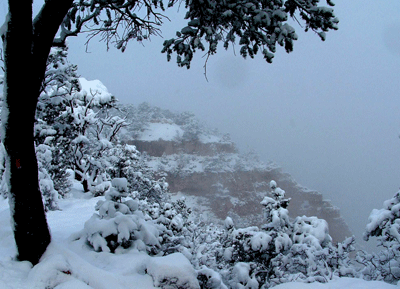 |
Saturday morning, I sat at my picnic table surrounded by flat scrubby land and overwhelming blue sky. The air was brisk but the sun was warm. From a couple of miles away came the hum of I-40, from beyond that the whistle of a freight train, its boxcars snaking along the desert in the morning light. Far past the road and the rails, blue mountains hung low on the horizon. A crow circled overhead, I heard the beat of its wings as it passed me. The rest of the world was visible at a distance in this open flat land, but the crow and I were all alone in miles of land and sky.
I got to the Canyon by early afternoon on Saturday. The day had started out clear and sunny, but as I drove north of Flagstaff it was snowing hard, and when I reached the Canyon the sun was gleaming between thick clouds.
Who doesnít know about the Grand Canyon? Who hasnít seen photos their whole life? But Iíd never seen it before, and itís amazing. It almost made me feel patriotic, seeing this incredible place that we all grow up hearing about. Well, okay, not that far. But I did walk up to total strangers to remark at how astonishing it is. I used to say that whatís really amazing in the U.S. is its landscapes. Now that Iím seeing some of them, I think I was right. Lots of places have mountains and rivers and beaches. Quite a few places have charming old towns with crooked streets and tall narrow houses and cobbled market squares. But where else are there things like the Badlands and the Grand Canyon?
On Prairie Home Companion this week people reported on what they are thankful for. Well, Iím thankful for having the freedom to spend time traveling, and for all the interesting people Iíve met on the way. And for being able to visit the Grand Canyon and the Badlands and Ha Long Bay and a lot of other incredible places.
Sorry, thatís quite enough pompous speeches. I took my bike out on the road along the South Rim, which seemed more fun than riding the bus. It turned out to be hard. Iím not used to an elevation of seven thousand feet. Or Iím just out of shape. Going up the hills I huffed and puffed and dripped with sweat. Going down I flew, while the cold wind blew through me and I wondered if I should have peeled off the extra layer of fleece. Sometimes the sun came out, but as I rode I watched fog settle on the North Rim and the canyon get darker. The buses can carry bikes, which was a good thing, because as I cruised downhill into the last overlook it started to snow, hard. It was all quite surreal Ė finally seeing the Grand Canyon after forty-eight years, riding a bike along the rim in blistering cold, and getting caught in a snow squall when the sky had been clean blue and the sun brilliantly warm in the morning. At the overlook I got on a growing line to buy lovely steaming sweet cups of cocoa, and took mine along the trail to where it ended at the point of the cliff. The sky was a thick gray, the canyon dark and murky, and a bit of light filtered through the clouds where there should have been a sunset. Snowflakes drifted into my cocoa and I laughed in sheer delight to be there.
In the evening I slogged through the snow to see a slide show about the geology of the canyon, in a wonderfully warm and dry auditorium. The ranger was an enthusiastic geologist, happy to be in the best place in the world for someone interested in rocks. The slides were stunning, of course. Just imagine every huge panoramic shot of the canyon youíve ever seen, dyed in orange sunset or gleaming at dawn. I even learned a bit about rocks, which Iím sure to forget by next week.
When I left the auditorium the air was warm and moist and the snow was falling hard. I made my way up the road, brushing the snow off road signs with my mittens to read them in the narrow beam of my flashlight. Eventually I found the canyon rim, taking a long route along the road because I couldnít find the pedestrian paths, hidden under wet snow and sagging trees.
At the rim the canyon was invisible, lost in fog. The sky was a muddy charcoal, the black trees were outlined in clean snow that gleamed in the murky landscape. I edged along the rim trail, keeping as far from the invisible canyon as I could. Here and there footprints wavered across the path, left by some animal that had strayed out of the woods. No one else was there. I took off my hat, the better to hear the sounds of far-off airplanes and the wind whistling in my ears.
I climbed carefully down the steps to an overlook, where I leaned on a rail at the point of the cliff. I could just make out the wall facing me, from the bright snow caught on ledges and boulders and shrubs, showing where the wall had to be. Everything else was gone. The soft breeze sang past my ears, a miniature chorus that changed its tune as I turned my head.
